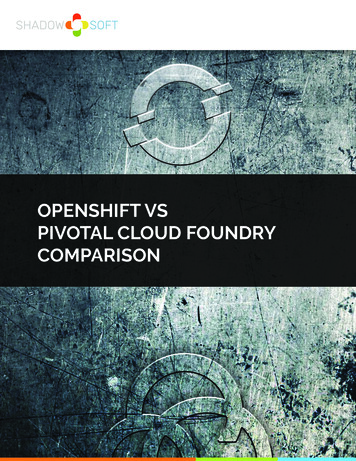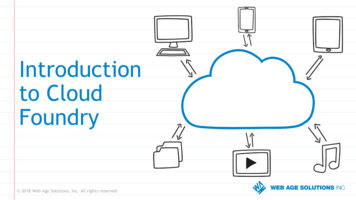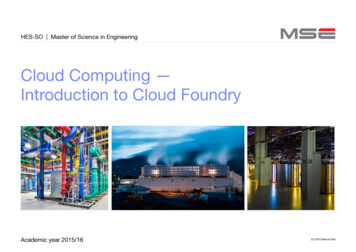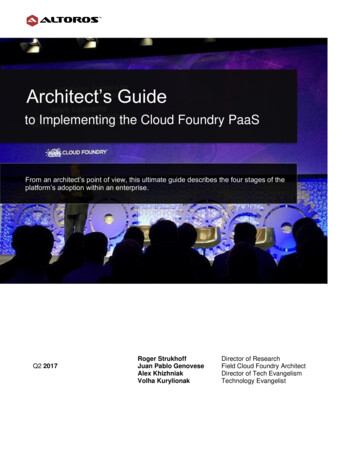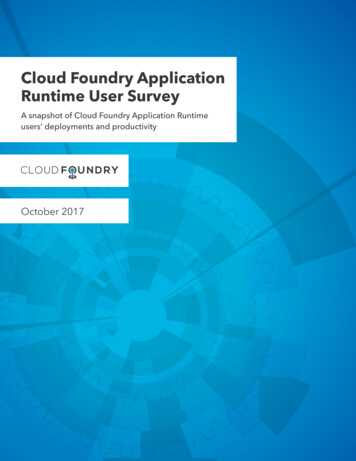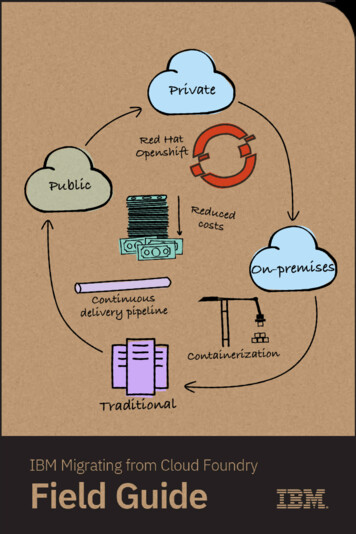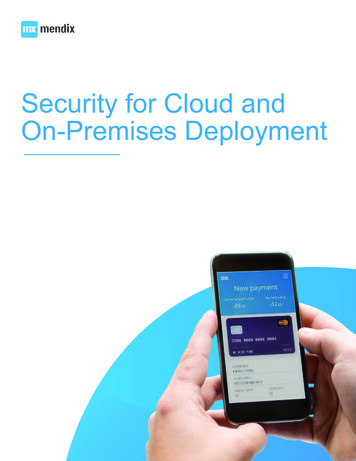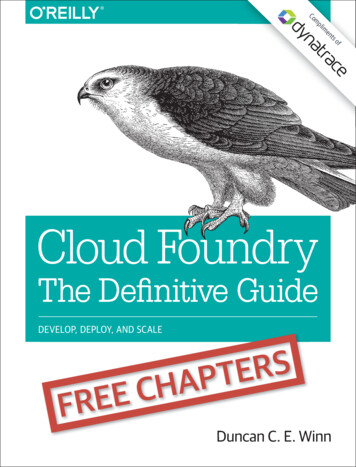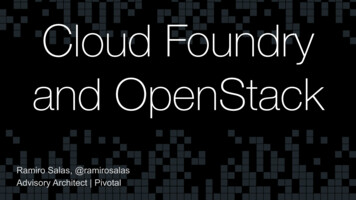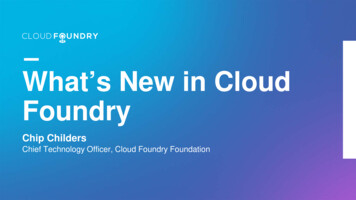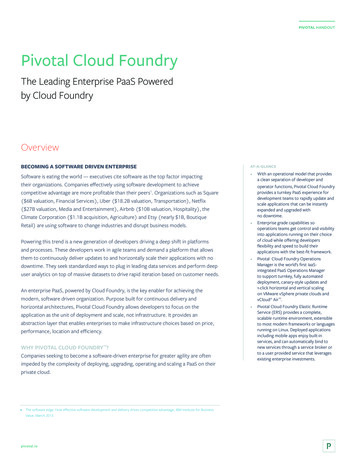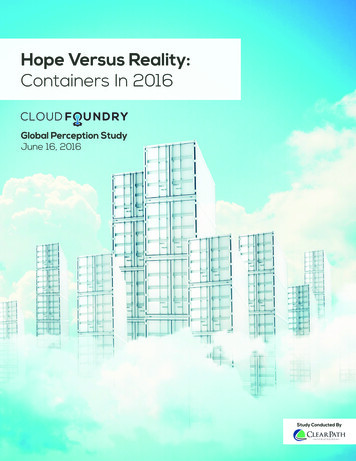
Transcription
Hope Versus Reality:Containers In 2016Global Perception StudyJune 16, 2016Study Conducted By
Key Findings1Containers are a keyenabler as organizationsadopt continuousdelivery as part of theirdigital transformation.2Increased containeradoption raises newconcerns aboutmanaging containersat scale.3Users prefer platformsover orchestrationtools for containermanagement.BackgroundCloud Foundry Foundation is home to the open source cloudapplication platform Cloud Foundry. The Foundation engagedClearPath Strategies, a strategic consulting and public opinion researchfirm for the world’s game-changing political and technology leaders,to conduct a first-of-its-kind, multi-national study of qualitative andquantitative research about the container phenomenon. The study,conducted in the first quarter of 2016, investigated the awarenessof container technologies, how they were used, key benefits andchallenges of their use, as well as what products and services wereused alongside containers. This report details trends in containerusage unveiled in that study.Cloud Foundry Foundation Global Perception Study2
IntroductionIn 2011, Marc Andreessen, founder of Netscape, LoudCloud, andAndreessen Horowitz, wrote a frequently cited essay for the WallStreet Journal on “Why Software is Eating the World.” Five years later,this process is well underway. Fortune 500 organizations acrossall industries—healthcare, insurance, financial services, automotive,telecom—are transforming into software-based businesses to competein quickly changing markets. Organizations are adopting agile practicesas well as new technologies with a focus on delivering more softwareat a faster rate than ever before.As these organizations search for tools to enable their digital transformation, they increasingly land oncontainers as a technology to enable that shift to cloud native application architectures. Organizationsare moving from the use of containers as a means of increasing density in existing infrastructure, tousing them to increase the velocity of application development as well as the scalability of applications.The increased adoption and deployment of containers over the last two years prove that companiesbelieve containers play an important role in this shift to cloud native application architectures. Researchfound that the majority of global organizations are evaluating or running container technologies. Whileonly a small percentage of respondents are running containers in production, a significant number ofusers say they are planning to run containers in production within the next year.As organizations take advantage of containers to enable their digital transformation, they discover thatthis technology comes with serious challenges.This report discusses the key findings from Cloud Foundry Foundation’s Global Perception Study (GPS).The GPS is a study conducted by the Cloud Foundry Foundation among identified global IT decision-makers.The study referenced throughout this report was conducted in the first quarter of 2016 with 711respondents across seven geographies (US, Canada, United Kingdom, Germany, China, Japan, SouthKorea) in five languages (English, German, Chinese, Japanese, Korean).Cloud Foundry Foundation Global Perception Study3
Who Took the Survey?34%33%33%EUROPEGermany, UKNORTH AMERICAUS, CanadaASIAChina, Japan,South Korean 711Respondents were divided nearly equally among four broad roles(developer, operations, IT manager, and line of business) fromcompanies with a minimum of 100 employees.Details from the research provide key insights into some of the major trends among IT decision makersaround the world and across industries. The research exposed fascinating trends in containers andplatform adoption. This report summarizes the data discovered—highlighting how far technologyadoption has come, but also that it is on the brink of a major technology shift in enterprise organizations.Primary ResponsibilityOrganization Size by Number of 0%100,000 30%Developers30%Operations20%IT Managers051015202530354020%Line of BusinessCloud Foundry Foundation Global Perception Study4
1Containers are a key enabler as organizationsadopt continuous delivery as part of their digitaltransformation.As organizations begin their digital transformation journey, they findcontainers to be an instrumental tool to start establishing continuousdelivery practices. Creating a repeatable and reliable process forapplication releases is a key principle for continuously deliveringsoftware. Based on the responses in this research, continuous deliveryseems to play a key role in organizations adoption of containers.When we dig into how containers are being used in organizations we find that the majority of respondents(54%) are using containers as “application development environments.” This indicates the potential for newcloud-native application architectures. Combine that with another 36% that are using containers to provide a“versioned runtime environment” and you see a trend towards deployment automation.How Containers are Being t Way toShare Resources42%Versioned RuntimeEnvironment36%Operating SystemEnvironment33%30%Replace VMs0102030405060Respondents were asked to select top 3 uses. n 374Secure/IsolatedEasy Version ControlConsistent EnvironmentFrom Dev ThroughProduction42%Cloud Foundry Foundation Global Perception Study37%36%5
ApplicationDevelopmentEnvironment54%Lightweight Way toShare Resources42%Versioned RuntimeEnvironment36%Operating SystemEnvironment33%30%Replace VMsWhile many organizations gain value in the “secure/isolated” capabilities (42%) that containers provide,we still see organizations honing in on continuous delivery capabilities, like “easy version control” (37%)0102030405060and a “consistent environment from development to production” (36%).Benefits of Containers42%Secure/Isolated37%Easy Version ControlConsistent EnvironmentFrom Dev %29%Devs Can Use IndividuallyPreferred Toolsets27%Spin Up and Downin Seconds25%Easy Image UpdatesPortability/Runs onAll Major Distributions23%Eliminate nts were asked to select top 3 benefits. n 374Consistent with the transition to “mainstream” use, operational concerns begin to come into focus,with 25% of respondents seeing “easy image updates” as a key container benefit, 23% finding valuein “portability/runs on all major distributions,” and 22% reporting confidence that containers are able to“eliminate environmental inconsistencies.”Interestingly, the research also found that 72% of User respondents believe “containers should betreated as just another component of infrastructure controlled policies,” as opposed to a “discrete stepin the application development and application deployment process.”Cloud Foundry Foundation Global Perception Study6
2Increased container adoption raises newconcerns about managing containers at scale.As organizations transform the way they develop and manageapplications, the one tool they turn to increasingly is containers. At thetime of our survey, a majority of companies (53%) had either deployed(22%) or were in the process of evaluating (31%) containers.Organizations are moving rapidly to explore and adopt containers. Of the 53% who have deployed or areevaluating containers, 16% have “already mainstreamed” their use. Another 64% expect to mainstream theuse of containers in the next year.Container Adoption & Usage31%Evaluating DeployingContainers16%Already mainstreamed34%64%Within the next yearNot CurrentlyUsing ContainersAt least a year or more15%5%Unsure013%Don’t Know22%1530456075n 374Currently UsingContainersn 711Cloud Foundry Foundation Global Perception Study7
16%Already mainstreamed64%Within the next yearAt least a year or more15%5%Unsure01530456075The research uncovered that the more exposure an organization has to containers, the morecomplexities are exposed. Respondents said they found containers “too complex to integrate intoexisting environments,” and require “too many skilled resources to manage.” This could be attributed towhere organizations are in their transformation journey, as they figure out how to develop cloud nativeapplications at a velocity that was previously unattainable. With this newfound velocity, organizationsfind themselves deploying and running containers at the scale of the enterprise.Biggest Deployment WorriesToo Complex toIntegrate into ourEnvironment45%35%Too Many SkilledStaff to ManageToo Much Time/Effort To Manage25%Not A Big EnoughCost Reduction25%Not A Big EnoughRevenue Driver12%Not A Big EnoughBoost to DevProductivity12%6%No Worries RunningContainers w/oManaged01020304050Note: Respondents selected their top 2 worries. n 711As container adoption increases in an organization, administrators must contend with containersprawl. The #1 challenge of containers, according to the 53% of respondents who are eitherusing or evaluating containers, is “container management.” “Container management,” by a largepercentage, is considered a more significant challenge to organizations today than “monitoring,”“persistent storage,” or even “security/isolation.” This reinforces the complexity challengesorganizations face managing containers at scale.Cloud Foundry Foundation Global Perception Study8
Top Container stentStorage36%Security/Isolation30%MultiContainer Apps27%21%OverburdensDevelopersDifficult toScale16%Multi-Tenancy16%Patching16%Can’t Run onMixed Distribution15%Not ProductionReady9%01020304050Respondents selected their top 3 challenges. n 374Organizations evaluating containers don’t feel this impact as acutely—yet. While they see thecomplexity challenges down the road, these Evaluators are not nearly as concerned as theorganizations who are running containers in production and are looking to scale at the speed oftheir market.Cloud Foundry Foundation Global Perception Study9
Containers alone are not enough.A key concern from Users and Evaluators alike is that containers increase the complexity of atechnology deployment, with 82% of Users saying that “containers can be a challenge to get to scale”and 80% of Users saying that “except in simple use cases containers are complicated.” Containersalone are not enough. In fact, 84% of Users say that “managing containers without a PaaS/cloudapplication platform would be a challenge” for them.Container Scale and ManagementUsersEvaluators82%Containers Can Be a Challengeto Get to Scale48%80%Except in Simple-Use Cases,Containers Can Be Complicated55%84%Managing Containers Withouta Provider Would Be a Challenge57%92%Containers are NecessaryComponent of PaaS/CloudApp Platform, but Alone areNot Enough76%020406080100Respondents were asked to answer True/False statement. n 374Another concern among both Users and Evaluators is that containers will be “too complex to integrateinto existing environments” without a platform. Similarly, 92% of Users say containers alone are notenough for an application development platform that delivers velocity at the speed they desire, and76% of Evaluators agree.While there is a gap between Users and Evaluators on managing containers, there is agreementthat both containers and a PaaS/cloud application platform are necessary for successful applicationdevelopment and deployment at enterprise scale.Cloud Foundry Foundation Global Perception Study10
3Users prefer platforms over orchestration toolsfor container management.Uncovered in this research, Users and Evaluators are relying lesson “self-managed orchestration tools” (15%) and more on bothprovider-managed and self-managed PaaS/cloud application platforms(45%) to manage their containers. This reinforces Finding #1 - thatmanaging containers at scale is complex - but that complexity can bereduced by implementing a platform.Container Orchestration and ManagementProvider-ManagedPaaS (Bluemix, etc.)32%Provider-ManagedContainer Service(EC2, etc.)CoreOS Tectonic(Enterprise Kubernetes)21%Self-Managed OnPremise Orchestrationw/o 3rd Party Tools (DIY)27%Hashicorp Nomad16%25%22%Docker SwarmSelf-Managed UsingOrchestration Tools(Swarm, etc)Mesosphere0510156%1%Tutum13%Self-Managed PaaS(CF, etc.)19%Apache Mesos15%20253035051015202530n 711If we expand those 15% using “self-managed orchestration tools,” the breakdown is interesting. CoreOSTectonic, a commercial distribution of Kubernetes and CoreOS, leads with 27%, followed closely byHashicorp’s Nomad (25%) and Docker Swarm (22%). Trailing the top three are Apache Mesos (19%),Mesosphere DCOS (6%), and Tutum (1%).The Users and Evaluators that already use a PaaS to run and manage containers (45%) provided a greatdeal of insight in the platforms that they are using or are under evaluation. Cloud Foundry leads thepack with 42% of the respondents, followed by Amazon Web Services (32%) and Microsoft Azure (31%).Cloud Foundry Foundation Global Perception Study11
Top Container Management Platforms42%Cloud Foundry32%31%Amazon Web ServicesMicrosoft Azure19%16%16%Oracle (Java/Database)Google App EngineForce.com t WeiyunRed Hat OpenShiftCloudBeesApcera2%1%Tsuru1%Baidu CloudNone4%01020304050n 323While platforms are the preferred way to run and manage containers at scale, this could easily shiftby the next survey, and use of orchestration tools could increase. We saw Docker adoption nearlydouble in just a few short months following the prior survey. From a global perspective, it is still tooearly to tell what role these technologies will play in container management.Cloud Foundry Foundation Global Perception Study12
SummaryThis report summarizes the broadest and deepest survey to date oncontainers. The research provided a peek into how and why containersare being used, as well as highlighted a few of the key challenges totheir adoption.Through this research we discovered that containers are being used as a tool by organizations toinitiate continuous delivery practices as they embark on their digital transformation journey. Whilecontainers alone are not going to provide continuous delivery, they are a good start.The research also showed that as the adoption of containers increases in an organization newchallenges are exposed when managing containers at scale. Containers alone are not enough. Usersat scale have made it clear - they prefer managing containers with a platform to a combination oforchestration tools.The report provides valuable insight into the current state of containers in organizations, as well as ahint of things to come. Organizations are undergoing a shift - a digital transformation. As organizationscontinue along this journey the role and their use of containers will evolve.Cloud Foundry Foundation Global Perception Study13
ClearPath Strategies Research NotesThis survey was conducted and produced by ClearPath Strategies(https://www.clearpath-strategies.com), a strategic consulting andresearch firm for the world’s game-changing leaders and progressiveforces. Following are the firm’s research notes for this survey.Respondent selection. Respondents in this survey were sourced from a leading global online panelprovider. They were selected from the panel based on geographic and role-based quotas, as well asscreening questions based on role in IT, decision-making role, company size, and how long they havebeen in IT. Selected respondents were further screened based on self-reported IT knowledge andattentiveness to survey questions.Role quotas. The survey divided respondents into four broad IT “roles”: Developer 30% (“I develop,deploy, and scale software applications.”), Operations 30% (“I maintain, monitor, and install IT systemsand platforms.”), Manager 20% (“I manage staff and oversee the direction and procurement for IT.”), andLine of business leadership 20% (“I lead a non-IT division but am responsible for IT decisions for myline of business.”). Respondents were asked to select which role most closely described their primaryresponsibility, even if no one was quite right or even if they performed more than one of these rules.Geographic quotas. The survey included respondents from the US (26%), UK (23%), China (16%), Japan(15%), Germany (10%), Canada (7%), and South Korea (2%). We combine these broadly into three regions:North America (33%; US and Canada), Europe (33%; UK and Germany), and Asia (33%; China, Japan, andSouth Korea).Industry. Although no industry-level quotas were deployed, we monitored the data to ensure that nosingle industry was over-represented in the data. The final breakdown of respondents by industry isas follows: IT (software, hardware, services) 23%, Manufacturing 18%, Financial services 10%, Businessservices 6%, Telecommunications/ISP/Web hosting 6%, Construction/engineering 5%, Government 5%,Health care 5%, Retail 5%, Education 3%, Consumer services 2%, Transportation and logistics 2%, lifesciences 2%, arts, entertainment, and recreation 1%, agriculture 1%, Extractive and refining 1%, Non-profit1%, Utilities 1%, and Other 3%.Cloud Foundry Foundation Global Perception Study14
Respondent screens. Potential respondents were screened on several criteria: Role: All respondents who selected either “IT professional / Support / Help Desk—I provide generalHW and SW support to non-IT staff” or “Non-IT professional—I do not work in an IT division and amnot responsible for IT decisions in my line of business” were excluded from the survey. Decision-making: All respondents must self-identify as a decision-maker. Specifically, in order toqualify for the survey, they must choose either “I am a key decision maker” (31%), “I directly influencethe decision” (43%), or “I do not directly influence the decision but do provide feedback necessaryto the decision makers” (27%). Anyone selecting “I am not involved in the decision making process”was excluded from the survey. Company size: All respondents must self-report that their companies have minimum 100employees. All potential respondents from smaller companies were excluded. In total, the surveyincludes 37% from companies with 100-999 employees, 35% from companies with 1,000 to 9,999employees, 18% from companies with 10,000 to 99,999 employees, and 10% from companies of100,000 or more employees. Time in IT. Respondents must have spent minimum 2 years working in or with IT in order to qualifyfor the survey. In total, 63% of respondents have spent 10 or more years in IT, with 37% having spent2-9 years. Information level. In our experience, it is possible to have “qualifying respondents” whonevertheless prove to have too little information or knowledge about the space to provide usefuldata from which to draw insights. We therefore apply an “information” screen to respondents aswell. Specifically, we ask whether or not respondents could explain certain terms to their colleagues,if asked to do so. In order to qualify for this survey, a respondent must say “yes” to this question forboth the terms “cloud computing” and “virtualization.” There were a few exceptional respondentsallowed in who did not say yes to both of these questions, but over 94% of respondents in the datasaid yes to both. “Attention” level. It is easy for respondents to speed through surveys or not pay enough attentionto provide useful data. We make an effort to exclude these respondents as well, as they providegenerally less useful data. In this survey, respondents were screened out for “attention” reasons ifthey said they could explain the made-up term “Greenfield as a Service (GaaS)” to a colleague inthe same question used for the Information Screen noted above. Additionally, respondents wereexcluded if—when answering the “PaaS awareness question”—they selected the logo/companynames for McDonald’s or Starbucks. Both of those companies were included in the list of PaaSproducts, and respondents were asked only to select the PaaS offerings they were familiar with andspecifically instructed not to select non-PaaS offerings.Cloud Foundry Foundation Global Perception Study15
Definitions. An important finding from our GPS studies to date—both qualitative and quantitative—is thatIT decision makers have a much less clear-cut vision of the technology and do not always make cleandistinctions between IaaS and PaaS as we might. Therefore, although we might not ourselves describeAWS, Azure, or Kubernetes as being true “PaaS” or might say they have “PaaS-like features,” therespondents may have a different perspective. Therefore, in the survey, the following definitions wereused for PaaS and Containers: PaaS. “PaaS—also called Cloud Application Platform—is a category of cloud computing servicesthat provides a platform allowing companies to develop, run, and manage enterprise and webapplications without the complexity of building and maintaining the infrastructure and middlewaretypically associated with developing and launching an app.” Containers. “Containers are a category of cloud computing services that enable developers andsysadmins to build, ship, and run distributed applications efficiently by packaging applications withall of its dependencies into a standardized unit. Containers can be deployed on a wide variety ofplatforms or infrastructures, managed either on-premises or in the cloud.”A note on Kubernetes. Regarding the topic of Kubernetes and its placement in different categories,our questionnaire allowed respondents two places to indicate Kubernetes use—as either a PaaS or acontainer management tool. Nevertheless, question wording and formatting impacts results, and anydifferences with other data may result from choices made in this process.A note on margin of error. It is technically impossible and improper to list a margin of error for asurvey of this type. The respondents for this sample were drawn from an online panel with an unknownrelationship to the total universe, about which we also do not know the true demographics. As such, theexact representativeness of this, or any similarly produced sample, is unknown.This work is licensed under a Creative Commons Attribution 4.0 International License.Cloud Foundry Foundation Global Perception Study16
Cloud Foundry FoundationGlobal Perception StudyCloudFoundry.org17
Cloud Foundry Foundation Global Perception Study 9 Top Container Challenges Respondents selected their top 3 challenges. n 374 Organizations evaluating containers don't feel this impact as acutely—yet. While they see the complexity challenges down the road, these Evaluators are not nearly as concerned as the
